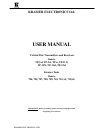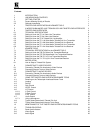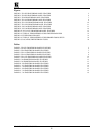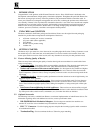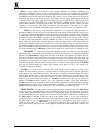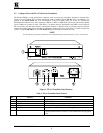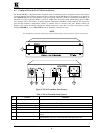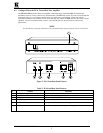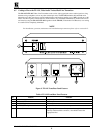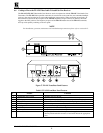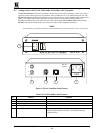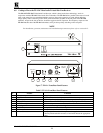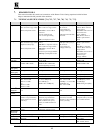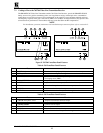
KRAMER ELECTRONICS LTD.
3
4.
TWISTED PAIR INTERFACES AND KRAMER TOOLS
This manual includes information about configuration, operation, maintenance and optional accessories for the
following Twisted Pair Interfaces and Kramer Tools (please note that machines from the same family have
several features in common):
TP-1xl- Video Line Transmitter
TP-12xl - Video/Audio Line Receiver
TP-2xl - Video Line Receiver
704, 705 - Video Line Transmitter/Receiver
TP-6 - Twisted Pair Line Amplifier
707, 708 - Video/Audio Line Transmitter/Receiver
TP-11N - Video/Audio Line Transmitter
709, 710 - Y/C Line Transmitter/Receiver
TP-12N - Video/Audio Line Receiver
711(xl), 712(xl) - AV Line Transmitter/Receiver
TP-11xl - Video/Audio Line Transmitter
5.
A WORD ON BALANCED LINE TECHNOLOGY AND TWISTED PAIR
INTERFACES
Video/Audio Balanced Line systems allow transmission of high quality (high signal/noise ratio) video and
audio signals on low quality twisted-pair cables thanks to a procedure of noise reduction. The process
principally consists of two main manipulative phases; in the first, the signal is electrically inverted in the
transmitter. The inverted and non-inverted signals are then transmitted together on a twisted-pair line,
accumulating noise along the way. At the receiver, the inverted signal is subtracted from the non-inverted one,
resulting in a signal of twice the amplitude (A – (-A) = 2A). Since the two inverted signals pick up the same
noise (with equal polarity) the subtraction eliminates the noise.
By using twisted-pair technology, simplification of studio and industrial wiring is easily achieved. The price of
Twisted Pair wires is far lower than that of coaxial cables, so it is an attractive alternative for an extensive array
of applications. Some of the twisted pair machines are fed by a 12VDC source, and are therefor suitable for
fieldwork. The DC fed machines can power one another using a 4-wire setup.
The Twisted Pair interfaces are divided into three families as follows:
Twisted Pair Transmitters
- Used to convert video and audio signals to a twisted-pair signal format
(balanced line). Some of the machines convert only video, while some convert video and also two channels
of audio to a single twisted-pair compatible signal, thus sparing the use of three coaxial cables. User-
accessible trimmers are sometimes used for signal level and cable compensation.
Twisted Pair Receivers
- Used to convert a twisted-pair format signal back to video and audio signals.
Receivers having a looping capability allow receivers to be chained together. Some have a polarity switch,
allowing the user to connect the wire using any polarity.
Twisted Pair Amplifiers
-
used to extend the operating distance of the twisted-pair system by adding
amplification and cable compensation along the twisted-pair wire. Machines which feed the power via a 4-
wire system eliminate the need to forward a power source to a remote location where the line amplifier is
installed.



